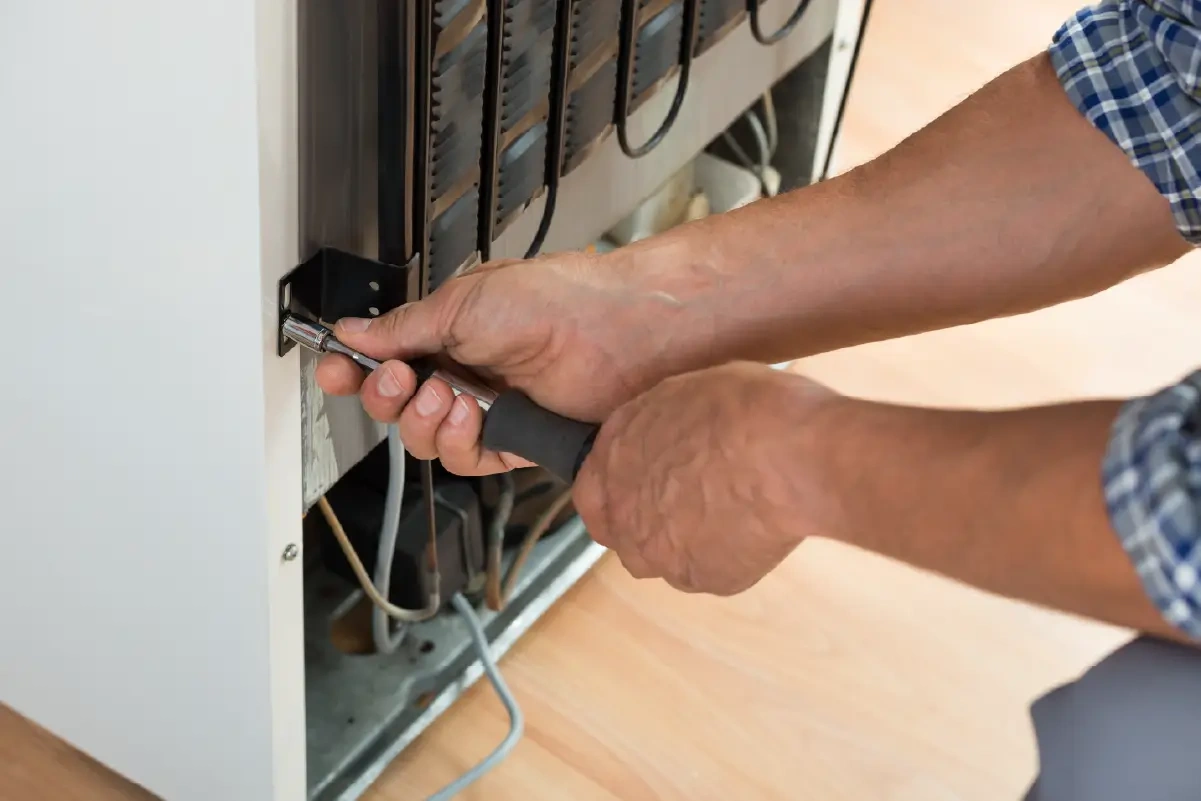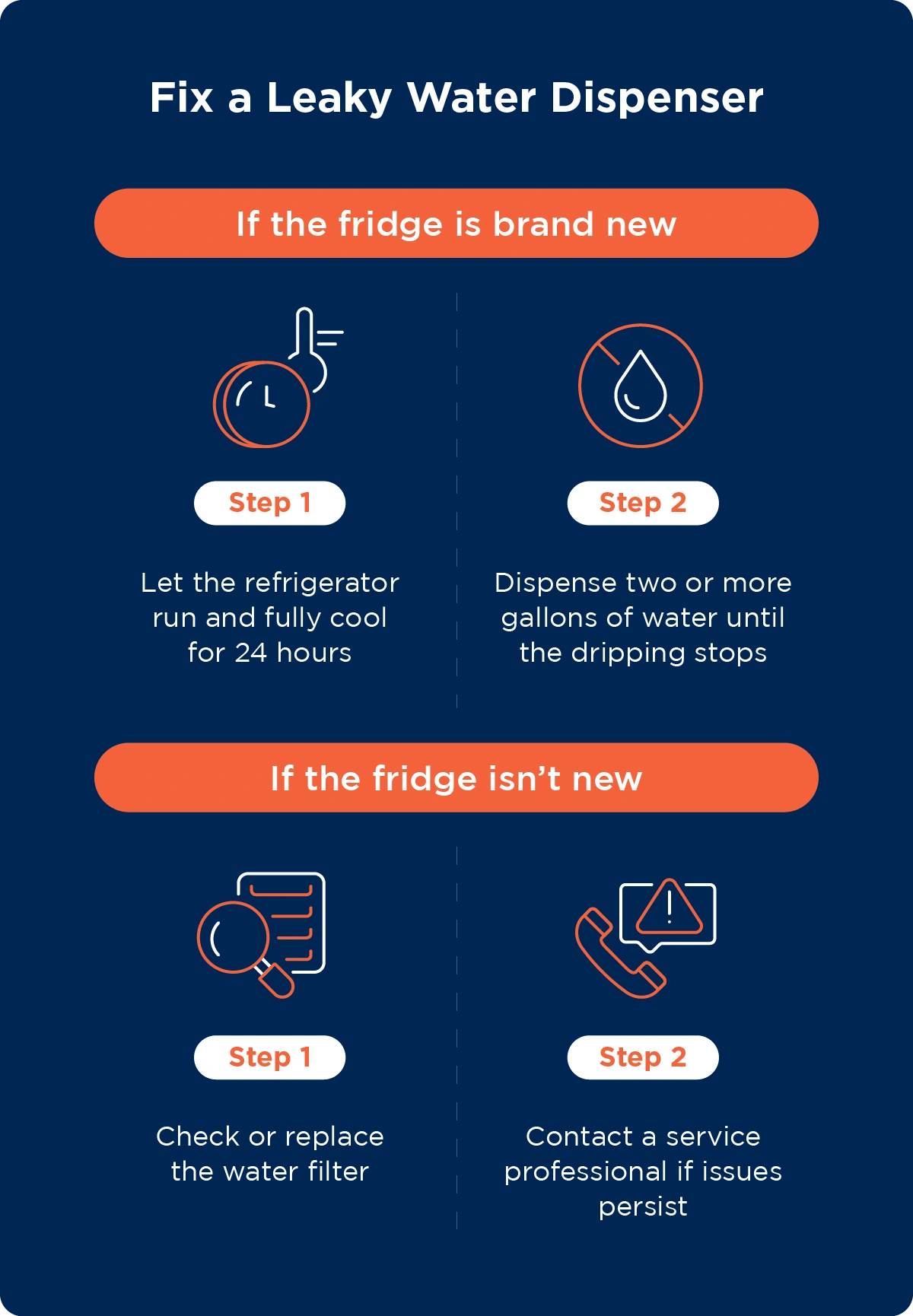Common Causes and Solutions for a Refrigerator Leaking Water
 A refrigerator leaking water is an unfortunate but not uncommon event. A dirty defrost drain is the most common culprit because this important gadget controls frost and condensation. However, there are several other potential causes of a fridge leak, and it’s important to be able to identify the signs of other issues like refrigerant leaks. So, grab some towels to soak up the leak, and let the investigation begin!
A refrigerator leaking water is an unfortunate but not uncommon event. A dirty defrost drain is the most common culprit because this important gadget controls frost and condensation. However, there are several other potential causes of a fridge leak, and it’s important to be able to identify the signs of other issues like refrigerant leaks. So, grab some towels to soak up the leak, and let the investigation begin!
Why Is My Refrigerator Leaking Water?
The first step to solving the issue is identifying where the water is coming from. Is it dripping from the fridge ceiling? Is it pooling under the produce drawer? Unplug your fridge for safety, check various areas for leaking, and try any of the steps below that apply to your situation.
1. Blocked Condensation Drain
In most fridge models, you’ll find the condensation drain just above the produce drawers or located in the freezer. A clog typically results from a build-up of food, ice, dust, and other debris. Regularly cleaning and clearing out your refrigerator can help prevent a clog, but even regular cleaning may not prevent a clog, so it’s important to know what to do when you have one. Here are the steps to follow:
Solution:
- Unplug the fridge and locate the drain pan. Empty if necessary.
- Locate the condensation drain, typically behind the produce drawers.
- Use a snake to clear the drain.
- If ice is the issue, pour about 2 cups of warm water and vinegar into the drain.
- Empty the pan.
- Repeat until the clog is clear.
- Clean and reinstall the drain pan.

2. Frozen Water Supply Line
If your ice maker is working properly, your issue is probably elsewhere. However, if your ice maker is not making ice, check if the water supply line or valve is frozen. You may also need a professional ice machine repair service to resolve this issue, especially if it involves dealing with toxic coolant.
This issue usually occurs if your fridge needs a more involved repair. If it needs a major clean out, or there’s an issue with the coolant or another malfunction, the evaporator coils get too cold, freezing other parts of your fridge, including the supply line.
Solution:
- Look for a frozen water line.
- Defrost your fridge (see instructions below).
- Turn the temperature setting down (maintain an internal temperature of 40 degrees Fahrenheit or less).
- If you’re still unsure why you’re having issues, then contact a service professional to take a look.
3. Frost Buildup
There may be too much ice buildup inside your refrigerator, which means you’ll need to defrost it. If you’ve ruled out causes like a seal issue and opening the fridge too often or for too long, there may be another cause. If too much ice builds up in your refrigerator, it will limit its ability to maintain a consistent temperature. The FDA recommends keeping your refrigerator at 40 degrees Fahrenheit or less for optimal food safety. So, if you’re dealing with too much frost in your fridge, here are the steps to follow:
Solution:
- Fully defrost the refrigerator. Check out our detailed instructions on how to clean your fridge properly.
- Take everything out of your fridge and store it in another refrigerator (if you have one)
- If you don’t have a second refrigerator, place any perishable items in coolers, with ice to keep them cold.
- Put down a towel to catch the water.
- Unplug the appliance for 8 to 12 hours.
- Keep a thermometer in your fridge to detect if it’s the proper temperature, and adjust the settings as necessary to prevent future frost buildup.
4. Broken Seal
If your door gasket isn’t sealing properly, moisture may enter your fridge and cause excess condensation that pools in the fridge. In a freezer with a poor seal, you may notice frozen drips or extra freezer burn on your food and around the freezer’s interior.
Solution:
- Close the refrigerator door on a dollar bill or a piece of paper to see if you can easily pull it out. If you can, your refrigerator and/or freezer is not sealing properly, which means it’s probably time for a replacement...
- Buy the right seal for the make and model of your fridge. You can find this information in your owner’s manual or by contacting the manufacturer.
5. Unbalanced Fridge
If a fridge isn’t level, this can cause it to leak. Refrigerators typically have adjustable feet on the bottom, so you can have a perfectly level fridge even if your floor isn’t level. To ensure your refrigerator is level, use a simple leveling tool (like when you’re hanging a painting) to check if the fridge is level. If you need to level your refrigerator, enlist the help of another person. This job is a lot easier with an extra set of hands.
Solution:
- Put your level on top of the fridge.
- Using the level, determine which side of the refrigerator is too high or too low. You can either raise the low side or lower the high side, whichever is easier.
- As one person pushes the top side of the refrigerator up, the other person should carefully adjust the feet on the bottom of the refrigerator. Adjust the stabilizing feet in small increments, making sure to set the fridge down each time you’ve made an adjustment.
- Once you have the refrigerator perfectly level, check its stability by firmly pushing on the door to see if it rocks from side to side or wobbles in any way.
- If it moves from side to side, continue adjusting until the refrigerator is level and doesn’t wiggle when pushed.
6. Broken Water Dispenser
Water dispensers are very convenient but they may begin to leak after a recent installation or if damaged in any way. Many times, water dispensers leak from having air trapped in the water line or if there’s a leak in the water line itself. Other issues, such as a broken dispenser switch, can also cause leaks, which can be fixed by a professional.
Solution:
- Let the refrigerator run for a full day.
- Dispense a couple of gallons of water.
- If the leak persists, check or replace the water filter in the refrigerator to ensure proper installation.
- If you continue to have issues, contact a service professional to investigate the problem.

7.Damaged Water Line
If your fridge has a water dispenser, it’s possible the water line is damaged, which may result in a water leak. You can also have a leaky water line if the valve is damaged or the line isn’t sealed properly. If your water bill is mysteriously high or other DIY fixes have failed, the issue could be with the water line.
Solution:
- Have an appliance expert check the water line for your refrigerator, and if needed, replace the damaged line.
8. High Humidity
If your home has a high humidity level, some of this moisture will get into your fridge. Each time you open the refrigerator door, moisture from your home gets into your fridge and builds up over time. This excess moisture will lower the internal temperature of your refrigerator and cause water to pool inside. Here’s how you can resolve this issue:
Solution:
- Unplug the fridge.
- Locate the drain pan behind the fridge. It may be behind a panel that you can remove with a screwdriver.
- Remove, empty, and clean the drain pan.
- Reinstall the drain pan and panel.
- Install a dehumidifier or refrigerator desiccant if needed.
9. Damaged Drain Pan
The drain pan holds small amounts of water until it can evaporate, but if the pan is damaged, rusted, or clogged with food and dirt, the water may drip onto the floor, which means you’ll have to clean or replace the pan.
Solution:
- Unplug the fridge.
- Locate the drain pan behind the fridge. It may be behind a panel that you can remove with a screwdriver.
- Remove, empty, and clean the drain pan.
- Inspect the drain pan for cracks or leaks.
- If needed, contact a professional to replace the pan.
- If the pan is intact, reinstall it and put the panel back in place.
Related Topic: Why Is My Washing Machine Leaking?
Why Is the Freezer Leaking Water?
The leaky culprit may not be in the fridge at all. If the freezer is leaking, the possible causes are very similar to refrigerator leaks:
- Broken drip tray
- Clogged water line
- Improper seal
- Blocked defrost drain
- Humid environment
- Damaged defroster
- Broken evaporation fan
To troubleshoot this, locate the defrost drain at the back of the freezer. You may have to remove the freezer light to see it. A small elbow-shaped pipe connects the drain to the back of the fridge. Pour some warm water down the drain to thaw it as you would for a refrigerator, and unblock the drain using a cotton swab or pencil tip. If the issue persists, you’ll likely need a professional’s assistance.
If there’s excess ice in the appliance, you might need to defrost the freezer. If this doesn’t seem to work, you may be dealing with a faulty ice maker part, such as the thermostat or heating element. Replacing those parts is not a DIY project, so contact a professional for their help.
Schedule Refrigerator Repair With Mr. Appliance
A leaky refrigerator is more than a nuisance to clean up. It can damage your floors or cause electrical shock if the water contacts electricity. If your refrigerator or freezer is leaking, go with the safer solution and trust your local Mr. Appliance experts to diagnose and fix the leak. You can easily schedule an appointment online.
This article is intended for general guidance only and may not be applicable to every situation. You are responsible for determining the proper course of action for your property and your situation. Mr. Appliance is not responsible for any damages that occur as a result of any advice or guidance derived from blog content. For the most accurate guidance, contact an independently owned and operated Mr. Appliance business for a professional custom and on-site assessment.
Refrigerator Leaking Water: FAQ
Keep reading for our expert answers to your top questions about leaking refrigerators.
What Should I Do If the Fridge Water Line Is Leaking?
A leaky fridge water line should be replaced by a professional. Schedule an appointment with one of our appliance service professionals today!
Why Is My Fridge Leaking Water Inside and Not Cooling?
A fridge might leak for many reasons, including a clogged drain, a damaged drain pan, and water supply issues. If the fridge also isn’t cold enough, you may need to replace the seal or get the appliance checked out by a professional.
How Do I Fix the Water in the Bottom of My Refrigerator?
If water is leaking from your refrigerator, try these fixes to resolve the most common issues.
- Use warm water and a snake to clear the condensation drain
- Check the drain pan for cracks
- Ensure the refrigerator is properly balanced
- Test the refrigerator door for a tight seal
If these don’t work, consider calling a professional to repair the appliance.
—------------------------------------------------------------------------------------------------------------
 Click to call
Click to call


